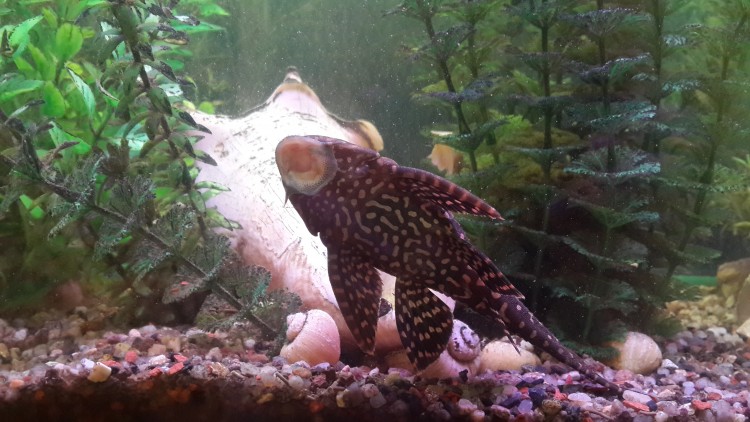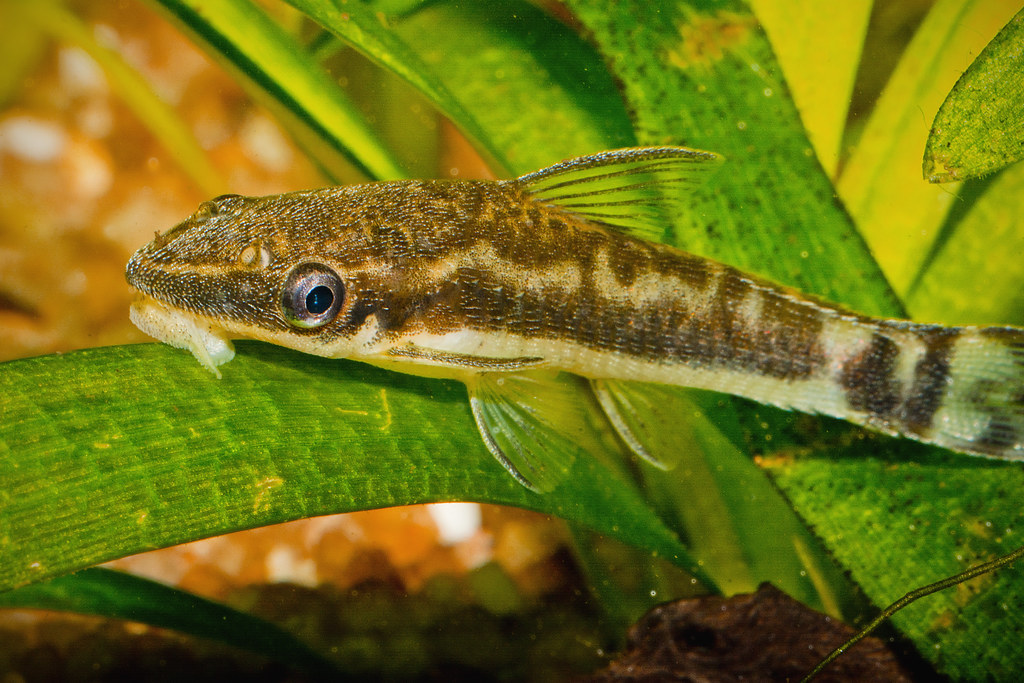Algae Eaters - What You Need To Know
- Aug 29, 2021
- Rita
- 2511 0 0

Algae eaters are an important part of any freshwater aquarium. They keep the glass, ornaments, and plants in your tank free of any algae growth. This means less work for you as well as a healthier tank in general.
If you’re considering getting some algae eaters in your tank, keep reading.

By aleander2137 - Own work, CC BY-SA 4.0, https://commons.wikimedia.org/w/index.php?curid=97397348
Things To Consider Before Getting Algae Eaters
Not all algae eaters will work in all tanks. Before you run to the pet shop to buy your favorite shrimp or fish, make sure your tank is suitable. Ask yourself the following questions:
- Do your water parameters support fish life?
If you don’t already have fish in your tank, make sure to check if your water parameters are safe for living creatures. If you have unnaturally high levels of ammonia or nitrites in your tank, algae eaters won’t survive. They also won’t survive if the pH is completely out of the safe range.
Also, check the temperature of your tank. This will affect what kind of algae eater will be able to survive there. Some prefer cold water while others are tropical. If you place the wrong kind in the wrong temperature, they just won’t make it.
- What is the aggression and activity level of your existing tank inhabitants?
If you have a tank full of very aggressive fish, getting a slow-swimming algae eater might not be a good idea. The other inhabitants of the tank will constantly harass the pure creature to its death.
If you have a peaceful community tank, adding algae eaters should be fairly simple, just make sure to pick the right size species and one that suits the water parameters of your tank.
- What is the oxygen level in your tank?
Oxygen levels will affect the kind of algae eater in your tank. Some prefer a tank with high levels of oxygen while others do just fine in lower levels. Make sure to choose the correct species depending on the level of oxygen in your tank.
- How strong is the current in your tank?
Algae eaters also come from different environments. Some are strong swimmers and prefer strong currents in your tank while others are terrible at swimming and will only get stressed and sick and a tank with strong currents. Make sure to research the kind of fish that is right for your tank before you get one.
- What is the layout of your tank and how dense is the foliage?
The last thing you’ll have to consider is the layout of your tank and how densely the foliage grew. Some algae eaters do well in a densely overgrown tank while others need some open water to swim and breath.

Otocinclus by AJC1
Types Of Algae Eaters
There are different types of algae eaters. You get fish that eat algae as well as shrimps and snails. Here are a few species of each to consider for your tank:
Algae-Eating Fish
If you want a fish to clean your tank, consider the following:
- Otocinclus Catfish
Otocinclus catfish, also plainly known as otos are excellent when it comes to riding a tank of algae. They are also quite small growing only 1.5 inches to 2 inches long making them ideal for small aquariums. They are also very peaceful which makes them great additions to a community tank.
Temperature: 72 - 79°F
pH: 6.8 - 7.5
Tank size: 10+ gallons
- Twig Catfish
These catfish are one of the best algae eaters out there but they are quite rare. They will eat a variety of fish food as well as clear your tank of green algae. Unfortunately, they aren’t the easiest fish to care for. Keep them in a tank with high oxygen levels and some current. Make sure your water quality stays pristine and you shouldn’t have any problems.
Temperature: 75 - 80°F
pH: 6.5 - 7.5
Tank size: 30+ gallons
- Siamese Algae Eater
Siamese algae eaters aren’t picky when it comes to the kind of algae they eat. They are one of the few species that will even take care of the dreaded black beard algae in your tank. They also help to control flatworm populations and will eat other fish waste in your tank as well. They are also excellent additions to planted tanks since they don’t tend to damage the live plants while grazing algae.
Temperature: 75 - 79°F
pH: 6.5 - 7.0
Tank size: 25+ gallons
- Chinese Algae Eater
This particular algae eater isn’t the best algae eater out there but it has its own advantages. This particular fish gets quite big and can be a bit aggressive. This makes them ideal for tanks with semi-aggressive fish on the larger side of things like African Chilids setups.
Temperature: 74 - 80°F
pH: 5.8 - 8.0
Tank size: 30+ gallons
- Plecos
There are a large number of pleco species all excellent at algae eating. They can range in size some being better for big tanks while others do just fine in smaller aquarium setups.
Bristlenose pleco is quite a stunning specimen you can consider for your aquarium. These little guys grow to about 4 inches which makes them suitable for most medium-sized aquariums.
Temperature: 73 - 81°F (Bristlenose pleco) 74 - 80°F (Common pleco)
pH: 5.8 - 7.8 (Bristlenose pleco) 7.0 - 8.0 (Common pleco)
Tank size: Dependant on species (20+ gallons for bristlenose pleco or 75+ gallons for common pleco)
- Livebearers
This might come as a surprise, but livebearers like guppies, platys, mollies, and swordtails are all excellent cleaners. They will quickly devour green algae in your tank and even eat some of the string algae that dare to bloom.
Temperature: 74 - 78°F
pH: 7.0 - 8.4
Tank size: Dependant on species (5+ gallons for endlers, 10+ for platies, or 30+ for mollies and swordtails)
Algae-Eating Shrimps

By Seotaro - Own work, CC BY-SA 3.0, https://commons.wikimedia.org/w/index.php?curid=3195549
If you want some diversity in your tank, consider adding some shrimps. The following shrimps will help to keep your tank clean:
- Cherry Shrimp
These stunning creatures are often kept as ornamental shrimps. They are quite easy to care for and will readily breed in your tank. Despite looking stunning in any tank, they are also excellent grazers contributing to the tank by keeping algae in control.
Temperature: 65 - 73°F
pH: 6.5 - 7.5
Tank size: 5+ gallons
- Amano Shrimp
Amano shrimp have a repetition as the best algae-eating shrimp species. They are quite large which means they are able to better defend themselves in community tanks and will also eat the algae that grow. Despite algae, they will also eat decaying plant matter as well as leftover fish food.
Temperature: 65 - 78°F
pH: 6.5 - 8.0
Tank size: 5+ gallons
Algae-Eating Snails
For a little more diversity, you can also consider adding snails. The following snails not only looks stunning in an aquarium but will also help to keep algae from taking over your tank:
- Nerite Snail
Nerite snails are the best algae-eating snails out there. They are in high demand in the pet trade for this exact reason. They also look stunning and won’t breed in your tank. Despite being excellent grazers, they won’t damage your live plants.
Temperature: 72 - 78°F
pH: 7.5 - 8.4
Tank size: 10+Gallons
- Mystery Snail
These snails are a smaller species of apple snail. They are excellent additions to a tank since they eat dead plant matter, leftover fish waste as well as a variety of algae species.
Temperature: 68 - 84°F
pH: 6.5 - 7.5
Tank size: 5+ gallons
- Malaysian Trumpet Snail
Malaysian trumpet snails are excellent for cleaning underneath your substrate. They will burrow themselves in and turn over the substrate in the process. This helps to aerate the soil for your plants and prevent the buildup of toxic gas. They also come out to eat algae in the upper levels of your tank if the food at the bottom becomes scarce. The only downside is they will breed and drastically increase in numbers quite quickly when left uncontrolled in your tank.
Temperature: 64 - 86°F
pH: 7.0 - 8.0
Tank size: 1+ gallons






About author